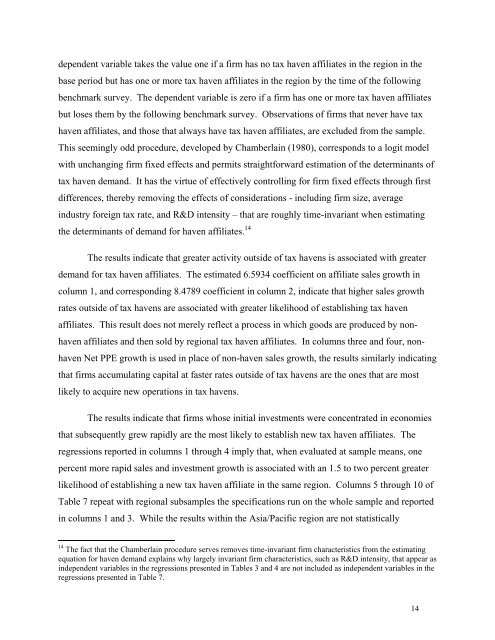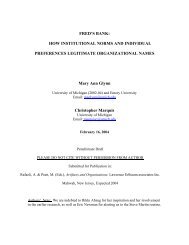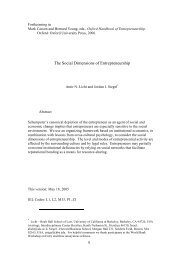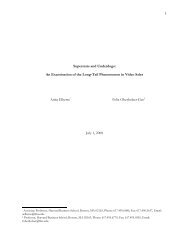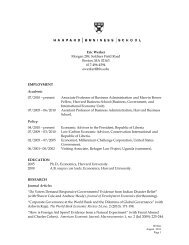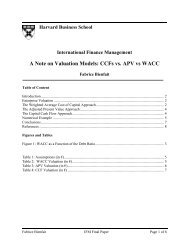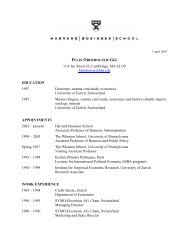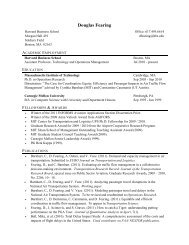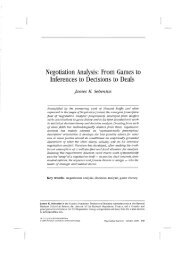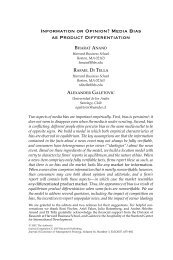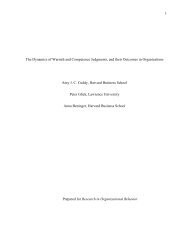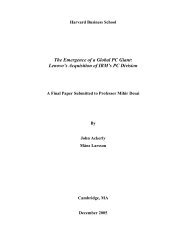The Demand for Tax Haven Operations - Harvard Business School
The Demand for Tax Haven Operations - Harvard Business School
The Demand for Tax Haven Operations - Harvard Business School
You also want an ePaper? Increase the reach of your titles
YUMPU automatically turns print PDFs into web optimized ePapers that Google loves.
dependent variable takes the value one if a firm has no tax haven affiliates in the region in the<br />
base period but has one or more tax haven affiliates in the region by the time of the following<br />
benchmark survey. <strong>The</strong> dependent variable is zero if a firm has one or more tax haven affiliates<br />
but loses them by the following benchmark survey. Observations of firms that never have tax<br />
haven affiliates, and those that always have tax haven affiliates, are excluded from the sample.<br />
This seemingly odd procedure, developed by Chamberlain (1980), corresponds to a logit model<br />
with unchanging firm fixed effects and permits straight<strong>for</strong>ward estimation of the determinants of<br />
tax haven demand. It has the virtue of effectively controlling <strong>for</strong> firm fixed effects through first<br />
differences, thereby removing the effects of considerations - including firm size, average<br />
industry <strong>for</strong>eign tax rate, and R&D intensity – that are roughly time-invariant when estimating<br />
the determinants of demand <strong>for</strong> haven affiliates. 14<br />
<strong>The</strong> results indicate that greater activity outside of tax havens is associated with greater<br />
demand <strong>for</strong> tax haven affiliates. <strong>The</strong> estimated 6.5934 coefficient on affiliate sales growth in<br />
column 1, and corresponding 8.4789 coefficient in column 2, indicate that higher sales growth<br />
rates outside of tax havens are associated with greater likelihood of establishing tax haven<br />
affiliates. This result does not merely reflect a process in which goods are produced by nonhaven<br />
affiliates and then sold by regional tax haven affiliates. In columns three and four, nonhaven<br />
Net PPE growth is used in place of non-haven sales growth, the results similarly indicating<br />
that firms accumulating capital at faster rates outside of tax havens are the ones that are most<br />
likely to acquire new operations in tax havens.<br />
<strong>The</strong> results indicate that firms whose initial investments were concentrated in economies<br />
that subsequently grew rapidly are the most likely to establish new tax haven affiliates. <strong>The</strong><br />
regressions reported in columns 1 through 4 imply that, when evaluated at sample means, one<br />
percent more rapid sales and investment growth is associated with an 1.5 to two percent greater<br />
likelihood of establishing a new tax haven affiliate in the same region. Columns 5 through 10 of<br />
Table 7 repeat with regional subsamples the specifications run on the whole sample and reported<br />
in columns 1 and 3. While the results within the Asia/Pacific region are not statistically<br />
14 <strong>The</strong> fact that the Chamberlain procedure serves removes time-invariant firm characteristics from the estimating<br />
equation <strong>for</strong> haven demand explains why largely invariant firm characteristics, such as R&D intensity, that appear as<br />
independent variables in the regressions presented in Tables 3 and 4 are not included as independent variables in the<br />
regressions presented in Table 7.<br />
14


